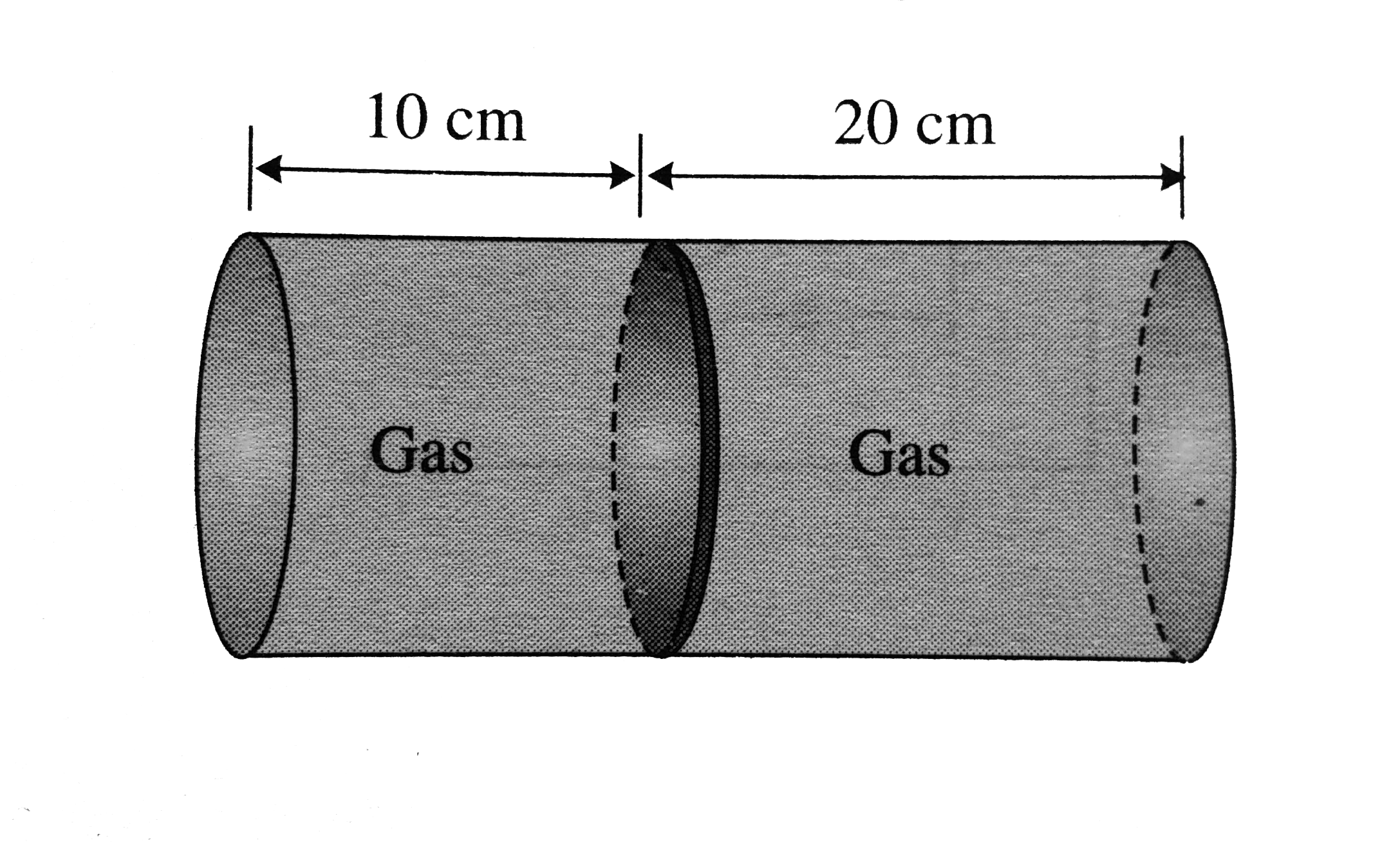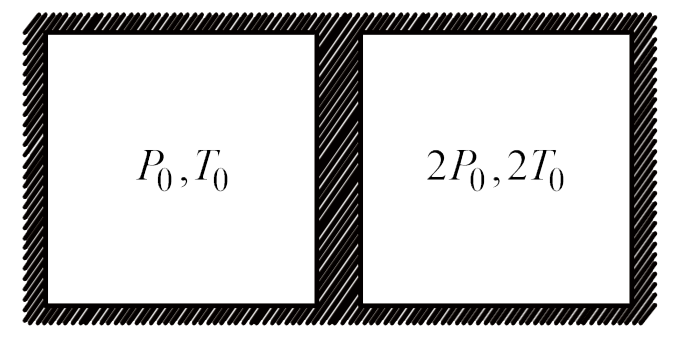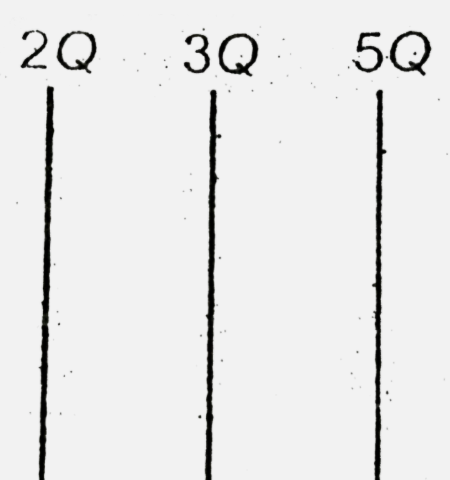Fig. shows a horzontal cylindrical container of length 30cm, which is partitioned by a tight-fiting separator. The separator is diathermic but conductws heat very slowly. Initially the separator is the state shown in the figure. The temperature of left part of cylinder is 100K and that on right part is 400K. Initially the separator is in equilibrium. As heat is conducted from right to left part, of separator after a long when gases on the two displacement of separator after a long when gases on the two parts of cylinder are in thermal equilibrium.

It is given that initially the separator is in equilibrium thus pressure on both sides of gas are equal say, it is Pi, If A be the area of cross-section of cylinder, number of moles of gas in left and right part n1 and n2 can be given as
n1=P1(10A)R(100) and n2=Pi(20A)R(400)
Finally if separator is displaced to right by a distance x, we have
n1=Pf(10+x)ARTf and n2=Pf(20−x)ARTf
If Pf and Tf be the final pressure and temperature on both sides after a long time.
Now if we equate the ratio moles n1n2 in initial and final state we get
n1n2=⎛⎝10A10020A400⎞⎠=(10+x)A(20−x)A
or 2(20−x)=10+x
or x=10 cm
Thus in final state when gases in both parts are in thermal equilibrium, the piston is displaced to 10 cm right from its intial position.
Topper's Solved these Questions
- Kinetic Theory of Gases and Gas LawsBOOK - PHYSICS GALAXY - ASHISH ARORACHAPTER - Kinetic Theory of Gases and Gas LawsEXERCISE - Discussion Question
18 Videos
- Kinetic Theory of Gases and Gas LawsBOOK - PHYSICS GALAXY - ASHISH ARORACHAPTER - Kinetic Theory of Gases and Gas LawsEXERCISE - Conceptual MCQs Single Option Correct
27 Videos
- HEAT TRANSFER BOOK - PHYSICS GALAXY - ASHISH ARORACHAPTER - HEAT TRANSFER EXERCISE - Unsolved Numerical Problems for Preparation of NSEP,INPhO&IPhO
66 Videos
- MAGNETIC EFFECTS OF CURRENT AND MAGNETISMBOOK - PHYSICS GALAXY - ASHISH ARORACHAPTER - MAGNETIC EFFECTS OF CURRENT AND MAGNETISMEXERCISE - U.N.P
79 Videos
Similar Questions
Shows a cylindrical tube of length 30cm which is partitioned by a tight-fitting separator.The separator is very weakly conducting and can freely slide along the Tube. Ideal gases are filled in the two parts of the vessel. In the beginning, the temperature in the parts A and B are 400K and 100K respectively. The separator slides to a momentary equilibrium position of the separator,reached after a long time.

View SolutionA cylindrical tube of length 30 cm is partitioned by a tight-fitting separator. The separator is very thin, very weakly conducting and can freely slide along the tube. Ideal gases are filled in the two parts of the vessel. In the beginning, the temperature in the parts A and B are 400 K and 100 K respectively. The separator slides to a momentary equilibrium position at which the length of the tube at part A is 20 cm. Find the final equilibrium position of the separator, reached after a long time.
View Solution
Knowledge Check
The separation of the left and right side of the heart is useful in
APreventing oxygenated and deoxygenated blood from mixingBPumping blood to different body parts effcientlyCExchange fo gasesDEnsuring that blood flows in one direction onlyA block moving in air breaks into two parts and the parts separate
Athe total momentum must be conservedBthe total kinetic energy must be conservedCthe total momentum must changeDthe potential energy must be conservedA block moving in air breaks into two parts and the parts separate ? .
Athe total momentum must be conservedBthe total kinetic energy must be conservedCthe total momentum must changeDthe potential energy must be conserved
An horizontal insulated cylindrical vessel of length 2l is separated by a thin insulating piston into two equal parts as shown. Each part contains n moles of an ideal monoatomic gas at temperature T. The piston is connected to end faces of cylinder with help of two springs each of spring constank k. Initially both springs are in relaxed state. The temperature of left part of cylinder is kept constant by some external means while heat is supplied to right part with help of filament. Answer following questions.
temperature of gas in right part in final equilibrium is
View SolutionShow a cylindrical tube of volume V_(0) divided in two parts by a frictionless separator. The walls of the tube are adiabatic but the separator is conducting, Ideal gases ate filled in the two parts. When the swparator is kept in the middle, the pressure are p_(1) and p-(2) in the left part and the right part respectively. The separator is slowly slid and is released at a position where it can stay in equilibrium. Find the volumes if the two parts. (figure)
View SolutionAn horizontal insulated cylindrical vessel of length 2l is separated by a thin insulating piston into two equal parts as shown. Each part contains n moles of an ideal monoatomic gas at temperature T. The piston is connected to end faces of cylinder with help of two springs each of spring constank k. Initially both springs are in relaxed state. The temperature of left part of cylinder is kept constant by some external means while heat is supplied to right part with help of filament. Answer following questions.
heat given by left part of cylinder to external arrangement is
View SolutionA diathermic piston divides adiabatic cylinder of volume V0 into two equal parts as shown in the figure. Both parts contain ideal monoatomic gases. The initial pressure and temperature of gas in left compartment are P0 and T0 while that in right compartment are 2P0 and 2T0. Initially the piston is kept fixed and the system is allowed to acquire a state of thermal equilibrium.

The pressure in left compartment after thermal equilibrium is achieved is
View SolutionThree charged conducting plates are separated by small distances as shown in figure. The charges on the plates are shown. Find the ratio of charge on right surface and left surface of the middle plate.

View Solution
